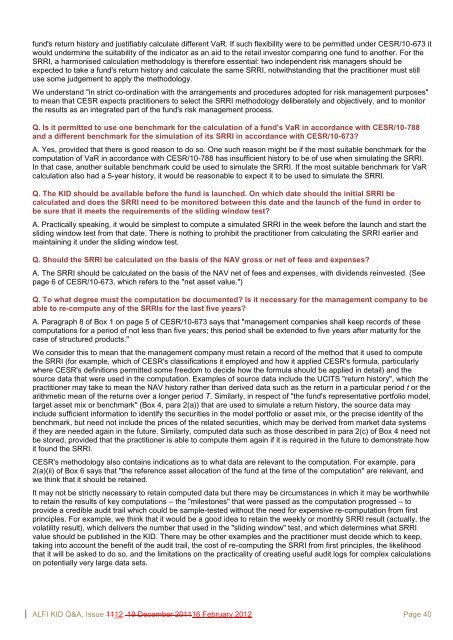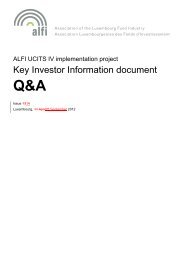Q&A - Alfi
Q&A - Alfi
Q&A - Alfi
You also want an ePaper? Increase the reach of your titles
YUMPU automatically turns print PDFs into web optimized ePapers that Google loves.
fund's return history and justifiably calculate different VaR. If such flexibility were to be permitted under CESR/10-673 it<br />
would undermine the suitability of the indicator as an aid to the retail investor comparing one fund to another. For the<br />
SRRI, a harmonised calculation methodology is therefore essential: two independent risk managers should be<br />
expected to take a fund's return history and calculate the same SRRI, notwithstanding that the practitioner must still<br />
use some judgement to apply the methodology.<br />
We understand "in strict co-ordination with the arrangements and procedures adopted for risk management purposes"<br />
to mean that CESR expects practitioners to select the SRRI methodology deliberately and objectively, and to monitor<br />
the results as an integrated part of the fund's risk management process.<br />
Q. Is it permitted to use one benchmark for the calculation of a fund's VaR in accordance with CESR/10-788<br />
and a different benchmark for the simulation of its SRRI in accordance with CESR/10-673?<br />
A. Yes, provided that there is good reason to do so. One such reason might be if the most suitable benchmark for the<br />
computation of VaR in accordance with CESR/10-788 has insufficient history to be of use when simulating the SRRI.<br />
In that case, another suitable benchmark could be used to simulate the SRRI. If the most suitable benchmark for VaR<br />
calculation also had a 5-year history, it would be reasonable to expect it to be used to simulate the SRRI.<br />
Q. The KID should be available before the fund is launched. On which date should the initial SRRI be<br />
calculated and does the SRRI need to be monitored between this date and the launch of the fund in order to<br />
be sure that it meets the requirements of the sliding window test?<br />
A. Practically speaking, it would be simplest to compute a simulated SRRI in the week before the launch and start the<br />
sliding window test from that date. There is nothing to prohibit the practitioner from calculating the SRRI earlier and<br />
maintaining it under the sliding window test.<br />
Q. Should the SRRI be calculated on the basis of the NAV gross or net of fees and expenses?<br />
A. The SRRI should be calculated on the basis of the NAV net of fees and expenses, with dividends reinvested. (See<br />
page 6 of CESR/10-673, which refers to the "net asset value.")<br />
Q. To what degree must the computation be documented? Is it necessary for the management company to be<br />
able to re-compute any of the SRRIs for the last five years?<br />
A. Paragraph 8 of Box 1 on page 5 of CESR/10-673 says that "management companies shall keep records of these<br />
computations for a period of not less than five years; this period shall be extended to five years after maturity for the<br />
case of structured products."<br />
We consider this to mean that the management company must retain a record of the method that it used to compute<br />
the SRRI (for example, which of CESR's classifications it employed and how it applied CESR's formula, particularly<br />
where CESR's definitions permitted some freedom to decide how the formula should be applied in detail) and the<br />
source data that were used in the computation. Examples of source data include the UCITS "return history", which the<br />
practitioner may take to mean the NAV history rather than derived data such as the return in a particular period t or the<br />
arithmetic mean of the returns over a longer period T. Similarly, in respect of "the fund's representative portfolio model,<br />
target asset mix or benchmark" (Box 4, para 2(a)) that are used to simulate a return history, the source data may<br />
include sufficient information to identify the securities in the model portfolio or asset mix, or the precise identity of the<br />
benchmark, but need not include the prices of the related securities, which may be derived from market data systems<br />
if they are needed again in the future. Similarly, computed data such as those described in para 2(c) of Box 4 need not<br />
be stored, provided that the practitioner is able to compute them again if it is required in the future to demonstrate how<br />
it found the SRRI.<br />
CESR's methodology also contains indications as to what data are relevant to the computation. For example, para<br />
2(a)(ii) of Box 6 says that "the reference asset allocation of the fund at the time of the computation" are relevant, and<br />
we think that it should be retained.<br />
It may not be strictly necessary to retain computed data but there may be circumstances in which it may be worthwhile<br />
to retain the results of key computations – the "milestones" that were passed as the computation progressed – to<br />
provide a credible audit trail which could be sample-tested without the need for expensive re-computation from first<br />
principles. For example, we think that it would be a good idea to retain the weekly or monthly SRRI result (actually, the<br />
volatility result), which delivers the number that used in the "sliding window" test, and which determines what SRRI<br />
value should be published in the KID. There may be other examples and the practitioner must decide which to keep,<br />
taking into account the benefit of the audit trail, the cost of re-computing the SRRI from first principles, the likelihood<br />
that it will be asked to do so, and the limitations on the practicality of creating useful audit logs for complex calculations<br />
on potentially very large data sets.<br />
ALFI KID Q&A, Issue 1112, 19 December 201116 February 2012 Page 40

















